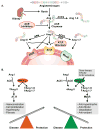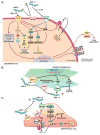Role of the ACE2/Angiotensin 1-7 Axis of the Renin-Angiotensin System in Heart Failure
- PMID: 27081112
- PMCID: PMC4939482
- DOI: 10.1161/CIRCRESAHA.116.307708
Role of the ACE2/Angiotensin 1-7 Axis of the Renin-Angiotensin System in Heart Failure
Abstract
Heart failure (HF) remains the most common cause of death and disability, and a major economic burden, in industrialized nations. Physiological, pharmacological, and clinical studies have demonstrated that activation of the renin-angiotensin system is a key mediator of HF progression. Angiotensin-converting enzyme 2 (ACE2), a homolog of ACE, is a monocarboxypeptidase that converts angiotensin II into angiotensin 1-7 (Ang 1-7) which, by virtue of its actions on the Mas receptor, opposes the molecular and cellular effects of angiotensin II. ACE2 is widely expressed in cardiomyocytes, cardiofibroblasts, and coronary endothelial cells. Recent preclinical translational studies confirmed a critical counter-regulatory role of ACE2/Ang 1-7 axis on the activated renin-angiotensin system that results in HF with preserved ejection fraction. Although loss of ACE2 enhances susceptibility to HF, increasing ACE2 level prevents and reverses the HF phenotype. ACE2 and Ang 1-7 have emerged as a key protective pathway against HF with reduced and preserved ejection fraction. Recombinant human ACE2 has been tested in phase I and II clinical trials without adverse effects while lowering and increasing plasma angiotensin II and Ang 1-7 levels, respectively. This review discusses the transcriptional and post-transcriptional regulation of ACE2 and the role of the ACE2/Ang 1-7 axis in cardiac physiology and in the pathophysiology of HF. The pharmacological and therapeutic potential of enhancing ACE2/Ang 1-7 action as a novel therapy for HF is highlighted.
Keywords: angiotensin 1–7; angiotensin II; angiotensin-converting enzyme 2; heart failure; renin-angiotensin system.
© 2016 American Heart Association, Inc.
Figures




References
-
- Givertz MM. Manipulation of the renin-angiotensin system. Circulation. 2001;104:E14–18. - PubMed
-
- Zaman MA, Oparil S, Calhoun DA. Drugs targeting the renin-angiotensin-aldosterone system. Nat Rev Drug Discov. 2002;1:621–636. - PubMed
-
- Bader M, Ganten D. Update on tissue renin-angiotensin systems. J Mol Med (Berl) 2008;86:615–621. - PubMed
-
- Dzau VJ, Re R. Tissue angiotensin system in cardiovascular medicine. A paradigm shift? Circulation. 1994;89:493–498. - PubMed
-
- Lavoie JL, Sigmund CD. Minireview: Overview of the renin-angiotensin system--an endocrine and paracrine system. Endocrinology. 2003;144:2179–2183. - PubMed
Publication types
MeSH terms
Substances
Grants and funding
LinkOut - more resources
Full Text Sources
Other Literature Sources
Medical
Research Materials
Miscellaneous

